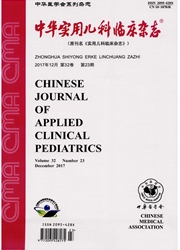

 中文摘要:
中文摘要:
目的探讨儿科重症监护病房(PICU)不同基因型人鼻病毒(HRV)作为病原体的重要性及其临床意义。方法收集2010年11月至2015年10月入住汕头大学医学院第二附属医院PICU患儿的咽拭子标本852份,应用巢式反转录-聚合酶链反应(RT-PCR)方法进行HRV检测,HRV阳性者经序列测定确定基因型别,并对各基因型检测阳性的病例进行临床分析。结果852份咽拭子标本中,鼻病毒阳性214例(25.12%),其中A型95例(44.39%),B型17例(7.94%),C型55例(25.70%),未成功分型47例(21.96%)。A、B、C型鼻病毒合并其他病毒检出阳性率分别为33.68%(32/95例)、29.41%(5/17例)、29.09%(16/55例)。A、B、C型鼻病毒感染患儿的临床特征相似,但喘息、气促在C型鼻病毒检出阳性患儿中更为多见。HRV各基因型检出率在不同严重程度疾病中的分布差异无统计学意义(H=0.631,P〉0.05);HRV与其他病毒混合检出的检出率与单一HRV检出的检出率在不同严重程度疾病中的分布差异亦无统计学意义(H=0.886,P〉0.05)。结论小儿重症感染中不同基因型HRV有较高的检出率,A、B、C型鼻病毒检测阳性病例临床症状相似,C型鼻病毒更容易引起患儿出现气促和喘息。
 英文摘要:
英文摘要:
ObjectiveTo discuss the significance of different types of human rhinovirus (HRV) as pathogen and the clinical features of different types of HRV in pediatric intensive care unit(PICU).MethodsEight hundred and fifty-two nasopharyngeal aspirates specimen (NPA) were collected from children who were admitted to PICU, the Second Affiliated Hospital of Shantou University Medical College from November 2010 to October 2015 and were tested by using nested reverse transcription-polymerase chain reaction(RT-PCR). Gene fragments for VP4/VP2 capsid protein amplified from HRV positive specimens were sequenced for HRV genotype confirmation.Then clinical characte-ristics of these HRV positive cases were analyzed.ResultsAmong these 852 specimens tested, 214(25.12%) were HRV positive, including 95 samples(44.39%)positive for HRV-A, 17 samples(7.94%)for HRV-B, and 55 samples(25.70%)for HRV-C determined by sequence analysis; while the species of 47 samples (21.96%) of the total were unclassified clearly.HRV-A, HRV-B, HRV-C co-infection with other respiratory viruses accounted for 33.68%(32/95 cases), 29.41%(5/17 cases), and 29.09%(16/55 cases), respectively.The clinical characteristics of children infected with HRV-A, HRV-B, HRV-C were similar, and wheezing and polypnea were more common with HRV-C infections than HRV-A and HRV-B infections.The severity among children positive for different groups HRV showed no significant difference(H=0.631, P〉0.05), as well as that between children co-infected with HRV and other viruses and those infected with HRV only(H=0.886, P〉0.05).ConclusionsDifferent types of HRV were major causes of infectious disease in pediatric critical disease.The clinical characteristics of children infected with HRV-A, HRV-B, HRV-C were similar.Wheezing and polypnea were more common with HRV-C infections than HRV-A and HRV-B infections.
 同期刊论文项目
同期刊论文项目
 同项目期刊论文
同项目期刊论文
 期刊信息
期刊信息
